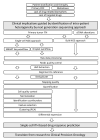A Portrait of Intratumoral Genomic and Transcriptomic Heterogeneity at Single-Cell Level in Colorectal Cancer
- PMID: 34833475
- PMCID: PMC8624593
- DOI: 10.3390/medicina57111257
A Portrait of Intratumoral Genomic and Transcriptomic Heterogeneity at Single-Cell Level in Colorectal Cancer
Abstract
In the study of cancer, omics technologies are supporting the transition from traditional clinical approaches to precision medicine. Intra-tumoral heterogeneity (ITH) is detectable within a single tumor in which cancer cell subpopulations with different genome features coexist in a patient in different tumor areas or may evolve/differ over time. Colorectal carcinoma (CRC) is characterized by heterogeneous features involving genomic, epigenomic, and transcriptomic alterations. The study of ITH is a promising new frontier to lay the foundation towards successful CRC diagnosis and treatment. Genome and transcriptome sequencing together with editing technologies are revolutionizing biomedical research, representing the most promising tools for overcoming unmet clinical and research challenges. Rapid advances in both bulk and single-cell next-generation sequencing (NGS) are identifying primary and metastatic intratumoral genomic and transcriptional heterogeneity. They provide critical insight in the origin and spatiotemporal evolution of genomic clones responsible for early and late therapeutic resistance and relapse. Single-cell technologies can be used to define subpopulations within a known cell type by searching for differential gene expression within the cell population of interest and/or effectively isolating signal from rare cell populations that would not be detectable by other methods. Each single-cell sequencing analysis is driven by clustering of cells based on their differentially expressed genes. Genes that drive clustering can be used as unique markers for a specific cell population. In this review we analyzed, starting from published data, the possible achievement of a transition from clinical CRC research to precision medicine with an emphasis on new single-cell based techniques; at the same time, we focused on all approaches and issues related to this promising technology. This transition might enable noninvasive screening for early diagnosis, individualized prediction of therapeutic response, and discovery of additional novel drug targets.
Keywords: colorectal carcinoma; intratumor heterogeneity; precision medicine; single-cell next-generation sequencing.
Conflict of interest statement
The authors declare no conflict of interest.
Figures
References
Publication types
MeSH terms
Grants and funding
LinkOut - more resources
Full Text Sources
Medical


